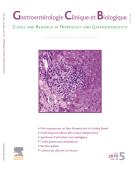FibroMeters: a family of blood tests for liver fibrosis - 28/10/08
 , J. Boursier a, b, F. Oberti a, b, I. Hubert a, b, Y. Gallois a, c, M.-C. Rousselet a, d, N. Dib a, b, V. Moal c, L. Macchi e, A. Chevailler f, S. Michalak a, d, G. Hunault a, J. Chaigneau a, A. Sawadogo a, b, F. Lunel a, f
, J. Boursier a, b, F. Oberti a, b, I. Hubert a, b, Y. Gallois a, c, M.-C. Rousselet a, d, N. Dib a, b, V. Moal c, L. Macchi e, A. Chevailler f, S. Michalak a, d, G. Hunault a, J. Chaigneau a, A. Sawadogo a, b, F. Lunel a, fSummary |
FibroMeters are blood tests for liver fibrosis with several specificities: two main diagnostic targets (fibrosis stage and area of fibrosis); adaptation to specific causes; and results confirmed by an expert system. Thus, FibroMeters comprise six different tests: one for staging and one for quantitation of liver fibrosis in each of the three main causes of chronic liver disease—chronic viral hepatitis, alcoholic liver disease (ALD) and non-alcoholic fatty liver disease (NAFLD). FibroMeters display a high overall diagnostic accuracy and are the only tests to correctly classify 100% of HCV patients without fibrosis or with cirrhosis. They have 90% predictive values in a higher proportion of patients than with other usual blood tests. A 90% correct classification is available in 100% of HCV patients with the following reliable diagnostic intervals: F0/1, F1/2, F2±1, F3±1. In real-life conditions, the reproducibility of FibroMeters is higher than that of liver biopsy or ultrasonographic elastometry. FibroMeters are robust tests with the most stable diagnostic performance across different centers. Optional tests are also available, such as a specific one for cirrhosis, which has a diagnostic accuracy of 93.0% (AUROC: 0.92) and a 100% positive predictive value for diagnosis of HCV cirrhosis. Determination by FibroMeters of the area of fibrosis – the only direct, non-invasive, quantitative measurement of liver fibrosis – are especially useful for following-up cirrhosis as it correlates well with clinical events. FibroMeters are also very accurate in HVB or HIV-HCV co-infected patients. The tests specific for ALD and NAFLD also have a high diagnostic accuracy (AUROCs: 0.96 and 0.94, respectively, for significant fibrosis).
Il testo completo di questo articolo è disponibile in PDF.Résumé |
Les FibroMètres sont des tests sanguins de fibrose hépatique avec plusieurs spécificités : deux cibles diagnostiques -stade et aire de fibrose-, adaptation à la cause, et résultats sécurisés par un système expert. Ainsi, il y a six principaux FibroMètres : un pour les stades et un pour la quantification de la fibrose dans chacune des trois principales causes d’hépatopathies : virus, alcool et stéatose. Le FibroMètre a une performance diagnostique globale très élevée et est le seul test à classer correctement 100% des patients infectés par le virus de l’hépatite C (VHC) sans fibrose ou avec cirrhose. Le FibroMètre a des valeurs prédictives à 90% chez une proportion élevée de patients. Une classification correcte à 90% est observée chez 100% des patients dans les intervalles diagnostiques suivants : F0/1, F1/2, F2±1, F3±1. Dans les conditions réelles, la reproductibilité du FibroMètre est plus élevée que celle de la biopsie hépatique ou de l’élastométrie impulsionnelle. Le FibroMètre est un test robuste avec la performance diagnostique la plus stable entre différents centres. Il y a plusieurs tests optionnels. Le FibroMètre spécifique de cirrhose a une performance diagnostique de 93% (AUROC: 0,92) et une valeur prédictive positive de 100% pour la cirrhose VHC. Le FibroMètre aire de fibrose, le seul test non invasif quantitatif de fibrose, est particulièrement utile au suivi des cirrhoses en raison de sa corrélation avec les événements cliniques. Le FibroMètre virus a une performance diagnostique élevée chez les patients co-infectés VHC-VIH ou atteints d’hépatite B. Le FibroMètre spécifique alcool ou stéatopathie métabolique a également une performance diagnostique élevée (AUROC: 0,96 et 0,94, respectivement, pour le diagnostic de fibrose significative).
Il testo completo di questo articolo è disponibile in PDF.Keywords : Liver fibrosis, FibroMeterss, Area of fibrosis, Blood tests, Non invasive diagnosis, Chronic viral hepatitis, Alcoholic liver disease, NAFLD, HIV co-infection, Cirrhosis
Mots clés : Fibrose hépatique, FibroMètres, Metavir, Aire de fibrose, Tests sanguins, Diagnostic non invasif, Hépatite chronique virale, Maladie alcoolique du foie, Stéatose métabolique, Co-infection VIH, Cirrhose
Abbreviations : ALD, AUROC, HCV, MRI, NAFLD, NPV, PPV
Mappa
Vol 32 - N° 6S1
P. 40-51 - Settembre 2008 Ritorno al numeroBenvenuto su EM|consulte, il riferimento dei professionisti della salute.

